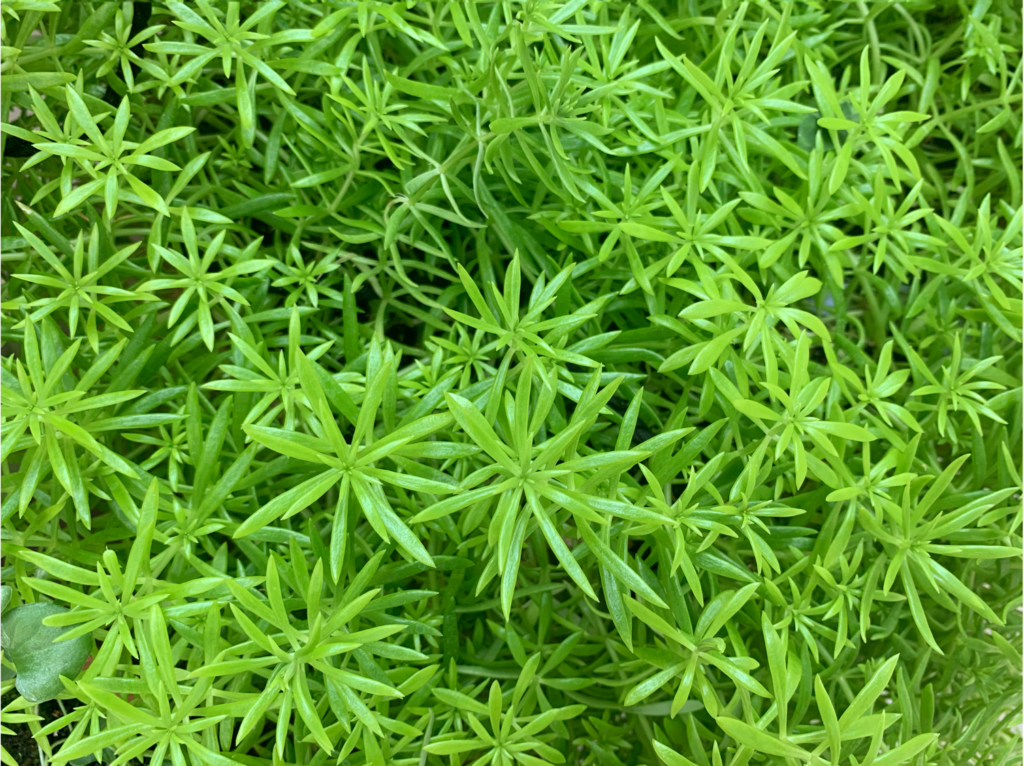By Leigh Siergewicz
When I first started learning about herbs, it was so exciting to find that the common weeds we see everywhere can be consumed for many benefits. After learning about cleavers, galium aparine, I can’t help but notice how abundant it is in spring. Cleavers are native to Europe, but have naturalized here.
Cleavers are part of the coffee family, and you can actually roast the seeds as a substitute for regular coffee. The whole plant, with leaves and stems, can be harvested fresh to make a tea, or it can be preserved in brandy as a tincture when the fresh herb is out of season. It is rich in micronutrients and makes a fun addition to your normal tea routine. On a hot day, you can have a cold infusion ready by putting fresh or dried cleavers in a pitcher of water in the refrigerator for 12-24 hours.
Cleavers grow in long stems low to the ground over and around other plants. Long, thin leaves grow in whorls of 6 to 8 around the stems at intervals all the way along. Small white flowers bloom in late spring and early summer. They have sticky burrs or “hitchhikers” that attach to clothing and animals to help their seeds disperse.
The most common use for cleavers is to help the lymphatic system, in herbalism known as a lymphagogue. They gently support the immune system and encourage the removal of normal waste products of the body, and are useful for swelling in the hands and feet. When used long-term, cleavers can help break up calcifications and fibrous tissue or scar tissue.
On the skin, cleavers can be helpful for healing wounds, ulcers and other skin irritations. You may find it as an ingredient in many commercial herbal skin salves. Although modern scientific evidence on cleavers is limited, a 2020 in vitro study discovered evidence to justify the traditional use of cleavers for skin wounds and infections; a raw infusion of cleavers was found to have antioxidant and immunostimulatory effects. Another 2016 study found promising preliminary results on cancer cells in vitro that should be further investigated.
Cleavers can also be used to gently soothe inflammation in the bladder and kidneys, and as a supplement to other therapies to break up kidney stones.
If you are unsure about identifying wild plants, always be certain to ask an expert before consuming. Otherwise, have fun trying to make a tea, tincture, or topical herbal formula with this very safe medicinal plant!
Leigh Siergiewicz, ND. Schedule online at: Betulanaturopathic.com. Please visit the online version of this article at vashonloop.com to see a list of additional readings.
Additional Reading
Atmaca, H., Bozkurt, E., Cittan, M., & Dilek Tepe, H. (2016). Effects of Galium aparine extract on the cell viability, cell cycle and cell death in breast cancer cell lines. Journal of ethnopharmacology, 186, 305–310. https://doi.org/10.1016/j.jep.2016.04.007
Ilina T, Skowrońska W, Kashpur N, et al. Immunomodulatory Activity and Phytochemical Profile of Infusions from Cleavers HIlina, T., Skowrońska, W., Kashpur, N., Granica, S., Bazylko, A., Kovalyova, A., Goryacha, O., & Koshovyi, O. (2020). Immunomodulatory Activity and Phytochemical Profile of Infusions from Cleavers Herb. Molecules (Basel, Switzerland), 25(16), 3721. https://doi.org/10.3390/molecules25163721erb. Molecules. 2020;25(16):3721. Published 2020 Aug 14. doi:10.3390/molecules25163721
Tilgner, S. (2009). Herbal medicine: From the Heart of the Earth. Wise Acres.
Wood, M. (2008). The Earthwise Herbal: A Complete Guide to Old World Medicinal Plants. North Atlantic Books.

